Overview
Recognizing the early signs of autism can be a daunting task for parents, yet it is crucial for ensuring the best outcomes for their children. Key indicators to look out for include:
- A lack of joint attention
- Delayed speech development
- Limited social interaction
Understanding these signs early can make a significant difference, as research shows that timely intervention leads to better developmental outcomes.
As parents, you may feel overwhelmed by the challenges of identifying these signs. You are not alone. Many families have faced similar concerns and found that early recognition of autism spectrum disorder opened the door to vital support and resources. Imagine the peace of mind that comes with knowing you are taking proactive steps for your child's future.
If you notice any of these signs, consider reaching out to a healthcare professional for guidance. Early diagnosis and intervention can pave the way for your child to thrive. Remember, seeking help is a sign of strength, and there are many resources available to support you on this journey. Together, we can foster understanding and create a nurturing environment for our children.
Introduction
Recognizing the early signs of autism is crucial for parents navigating the complexities of child development. With autism affecting 1 in 36 youths in the U.S., understanding these indicators can empower families to seek timely intervention and support. Yet, many parents may grapple with uncertainty—how can they distinguish typical developmental behaviors from potential warning signs? This article explores ten key early indicators of autism, offering insights that can help parents take proactive steps toward nurturing their child's growth and well-being.
About ASD Media: Empowering Parents with Early Autism Detection Resources
At ASD Media, we are deeply committed to enhancing the execution of ABA therapy, equipping caregivers and professionals with essential tools for the early identification of developmental disorders. Our mission is rooted in empowering families through education and community support, ensuring that parents have access to the latest insights and strategies to recognize early signs of autism. Did you know that autism affects 1 in 36 youths in the U.S.? This statistic underscores the urgent need for resources dedicated to the early signs of autism detection.
Community support programs are vital in facilitating the early diagnosis of early signs of autism, as they encourage collaboration among families, healthcare providers, and educators. Research shows that active community involvement can significantly improve the identification rates of early signs of autism. For instance, studies indicate that individuals diagnosed with early signs of autism before age 3 benefit from more effective interventions. A notable study published in the Journal of Autism and Developmental Disorders found that ABA therapy led to remarkable progress in adaptive behaviors for individuals on the autism spectrum.
Professional insights consistently emphasize the crucial role of community participation in raising awareness and providing resources, ultimately supporting families in their journey. By fostering a nurturing environment, ASD Media aims to improve outcomes for youth with ADHD, simplifying the often daunting process of early diagnosis and intervention for parents who frequently face emotional and financial challenges. Together, we can navigate these hurdles and create a supportive community for all families.
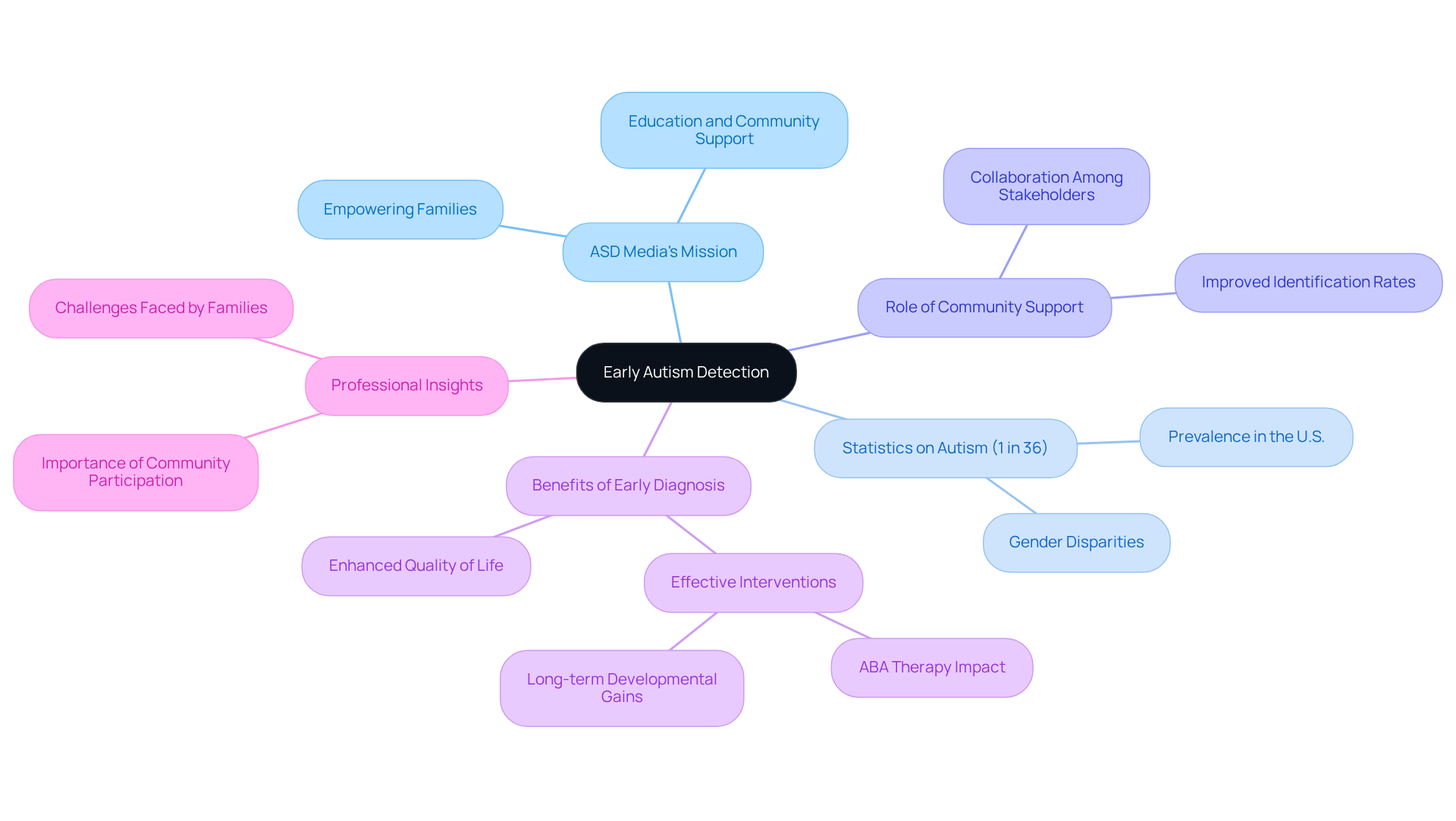
Lack of Joint Attention: Recognizing Early Communication Challenges
One of the early signs of autism that parents may notice is the lack of joint attention. This refers to the ability to share focus on an object or event with another person. For example, a young child might not shift their gaze between a toy and a caregiver, missing out on vital opportunities for interaction. This challenge can impact language development and social skills, making it crucial for parents to monitor their child's participation in joint attention activities. By encouraging behaviors like pointing or showing interest in shared experiences, parents can help nurture these important skills.
Research indicates that children with autism often engage in joint attention far less frequently than their peers with developmental delays, which can affect their language outcomes. Therefore, it’s essential for parents to actively promote shared focus by creating engaging environments and using strategies that inspire their children to participate in these interactions. Successful interventions have shown that children in the Joint Attention treatment group demonstrated faster progress in joint attention skills compared to those in the Control group.
Moreover, consistent engagement from adults plays a vital role in enhancing joint attention abilities, ultimately leading to improved communication skills over time. By recognizing and addressing the early signs of autism, parents can significantly influence their child's developmental journey, ensuring they receive the support they need to thrive.
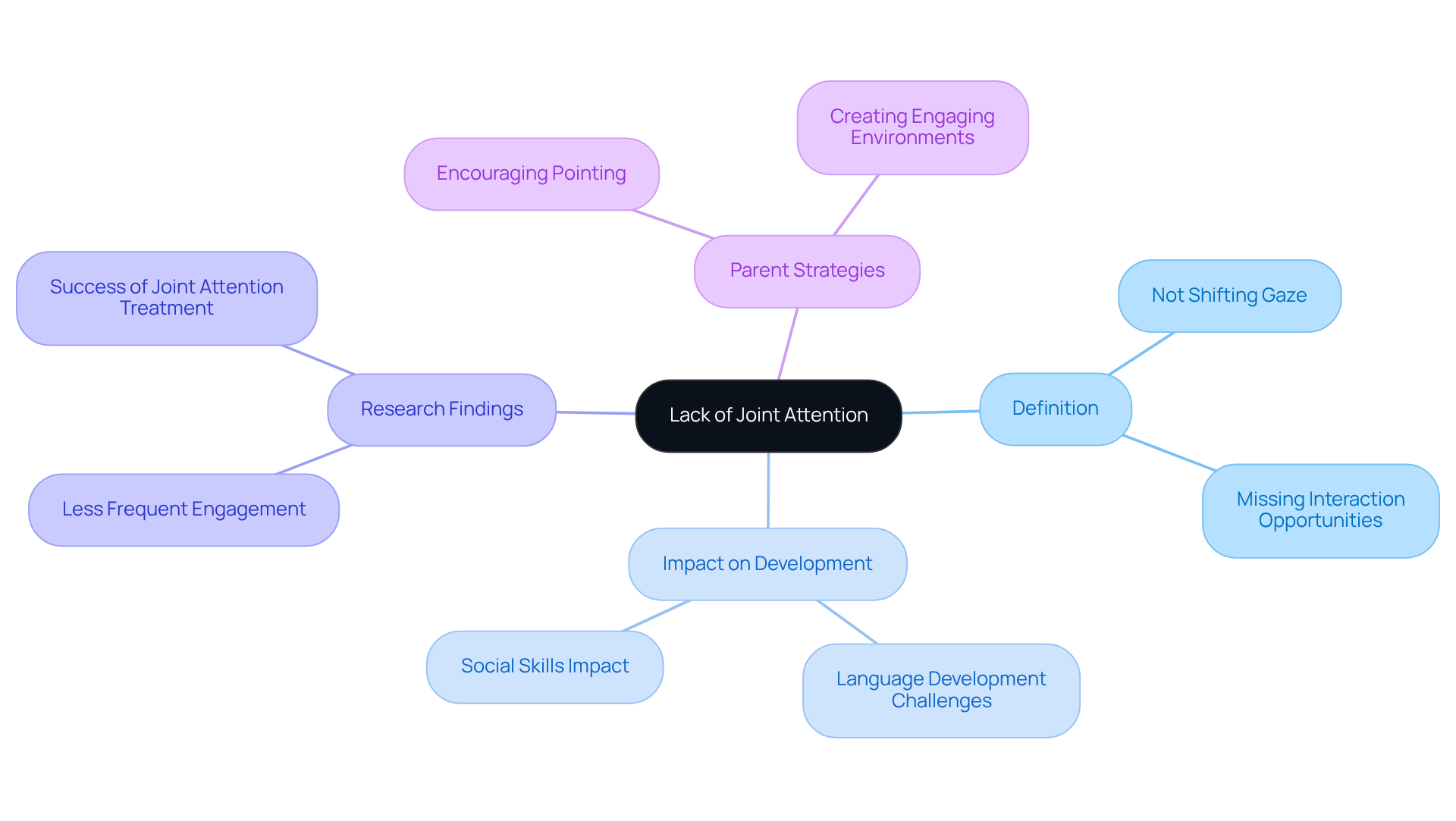
Delayed Speech Development: Identifying Communication Delays in Early Childhood
Delayed speech development can be a significant indicator of autism, and as a caring parent, it's crucial to be aware of the signs. For instance, many children may not babble by 12 months or use single words by 16 months. By 24 months, they should ideally be able to combine two words into simple phrases. Monitoring these milestones closely is essential, as early intervention can dramatically enhance communication outcomes.
Engaging in regular conversations, reading age-appropriate books, and encouraging verbal expression through play and language games are effective strategies to foster language development. It's important to remember that approximately 15% of children aged 18-35 months experience language delays. This statistic highlights the need for vigilance in recognizing these signs early on.
Moreover, children with delayed speech may face challenges in social interactions and academic performance. This makes prompt evaluation and intervention all the more essential. Effective interventions, such as speech-language therapy, have shown notable improvements in communication abilities, especially when initiated early. It's concerning that 40% to 60% of youth with untreated speech and language delays may continue to face significant challenges into adulthood.
By creating a language-rich environment and actively participating in your child's development, you can help mitigate the risks associated with speech delays. Supporting your child's overall growth is not just about addressing delays; it’s about nurturing their potential every step of the way.
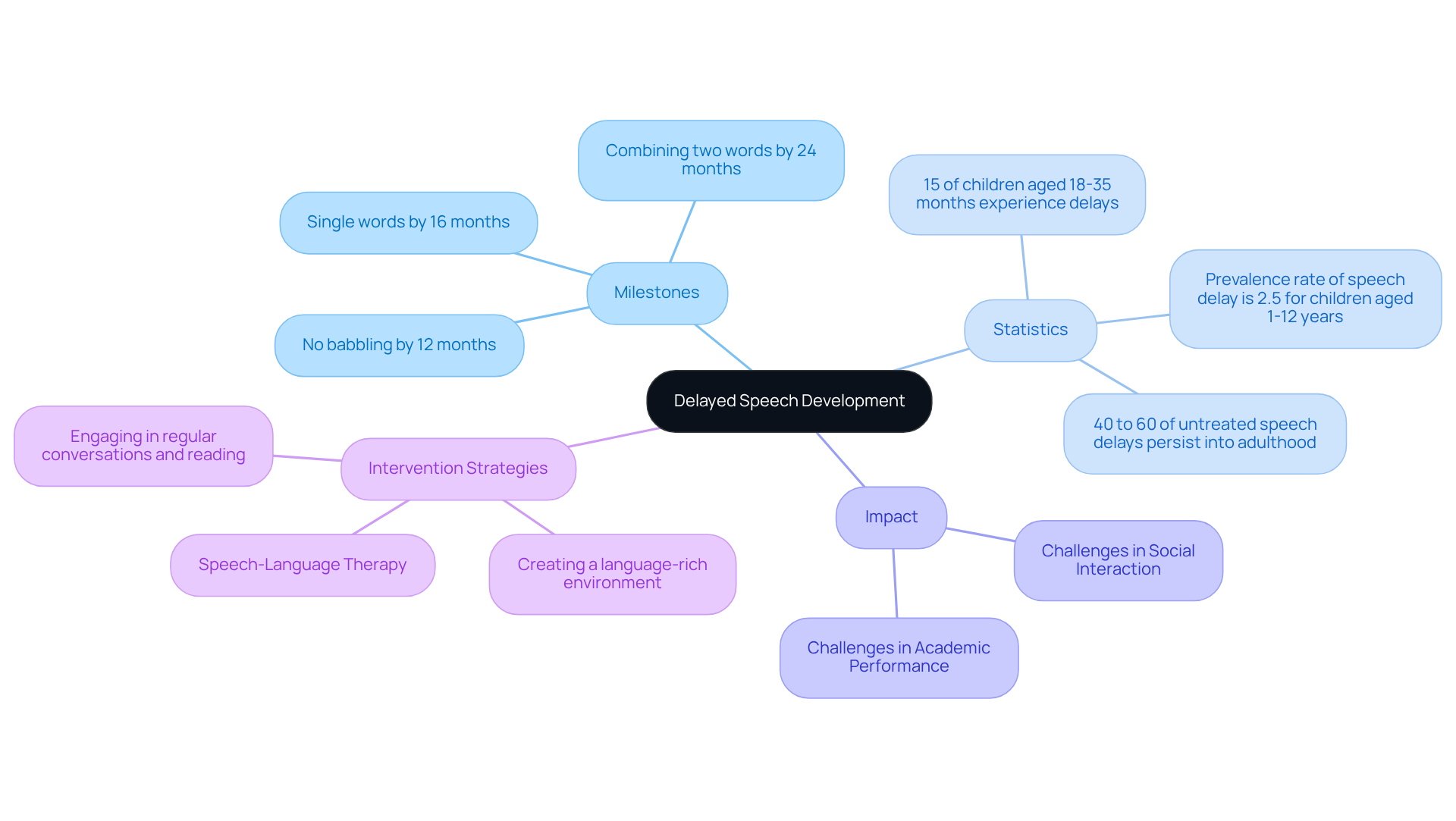
Limited Social Interaction: Understanding Withdrawal from Social Engagement
Children with early signs of autism often experience challenges in interpersonal interactions, which can leave them feeling withdrawn or disinterested in connecting with their peers or adults. They may not respond to social cues like smiling or waving, and their preference for solitary play can be considered early signs of autism. It’s important to recognize that promoting community involvement plays a crucial role in their development. Research indicates that around 40% of autistic youth also grapple with anxiety disorders, which can further hinder their social interactions.
Effective playdate initiatives have shown promise in enhancing interaction skills among autistic youth, as they help in recognizing early signs of autism by providing structured opportunities for engagement. Psychologists, such as A. Blythe LaGasse, highlight that these communal experiences can significantly alleviate feelings of isolation and improve emotional well-being. Parents are encouraged to actively facilitate social interactions through playdates and group activities, as these experiences are vital for helping children develop essential social skills and navigate social environments with greater confidence.
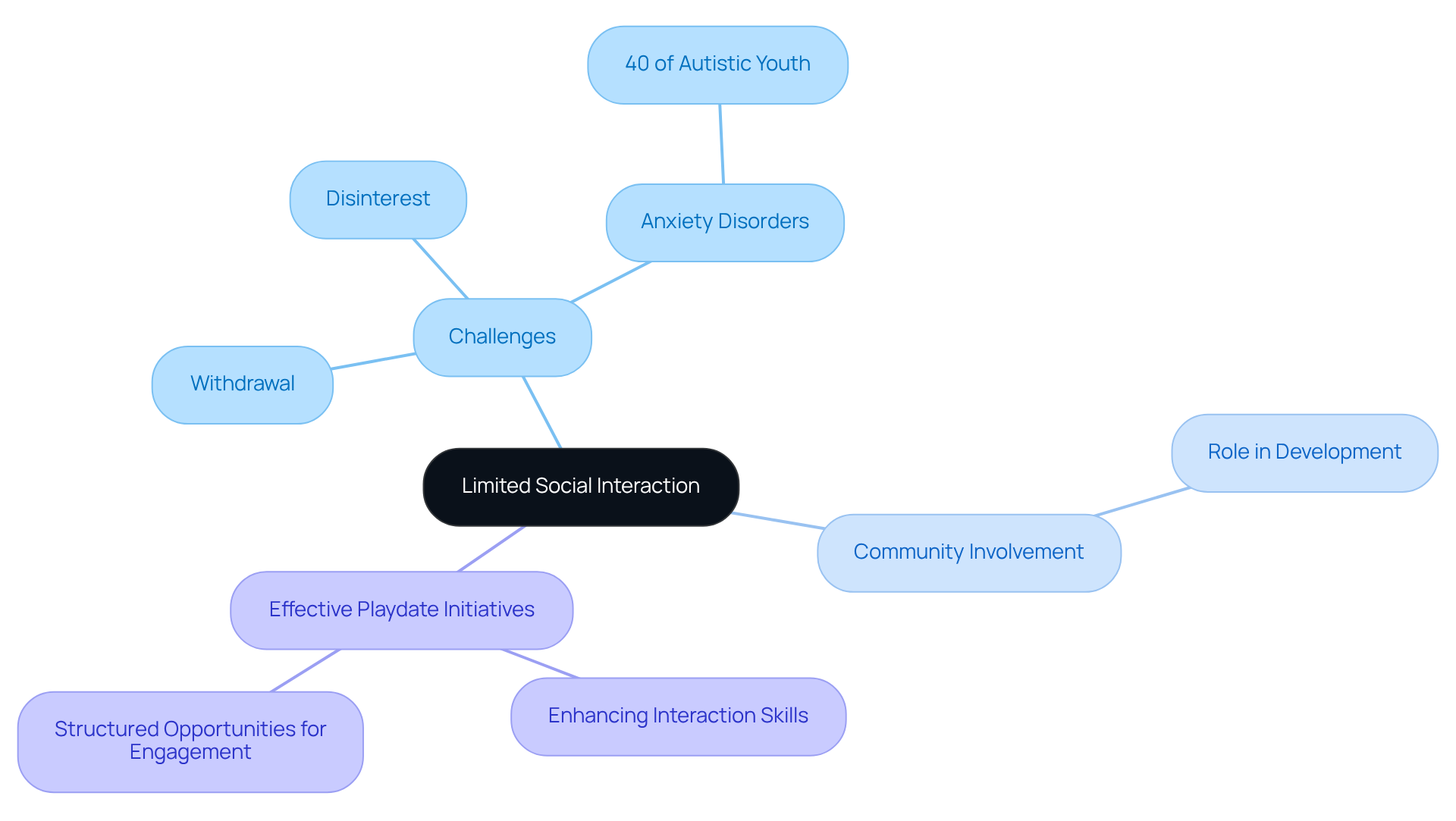
Repetitive Movements: Spotting Unusual Patterns in Behavior
Repetitive actions, such as hand-flapping, rocking, or spinning, often emerge in young individuals with developmental disorders. These behaviors can serve as comforting coping strategies for anxiety or sensory overload, helping to regulate overwhelming feelings. It’s important to note that studies indicate between 50% and 80% of these young individuals experience sleep issues, which can exacerbate anxiety and lead to increased repetitive behaviors.
As a caring parent, observing your child's behavior patterns is crucial; be vigilant for any excessive or atypical repetitive actions as they may indicate early signs of autism. Engaging with professionals can offer valuable insights and strategies for managing these behaviors.
As Lindee Morgan insightfully observes, 'RSM with objects forecasted distinct variance in the intensity of autistic symptoms in the fourth year beyond what was anticipated by social communication measures alone.'
By understanding the underlying reasons for these movements, you can create a supportive environment that effectively addresses your child's sensory needs, fostering a sense of security and well-being. Remember, you're not alone in this journey; seeking support can make a significant difference.
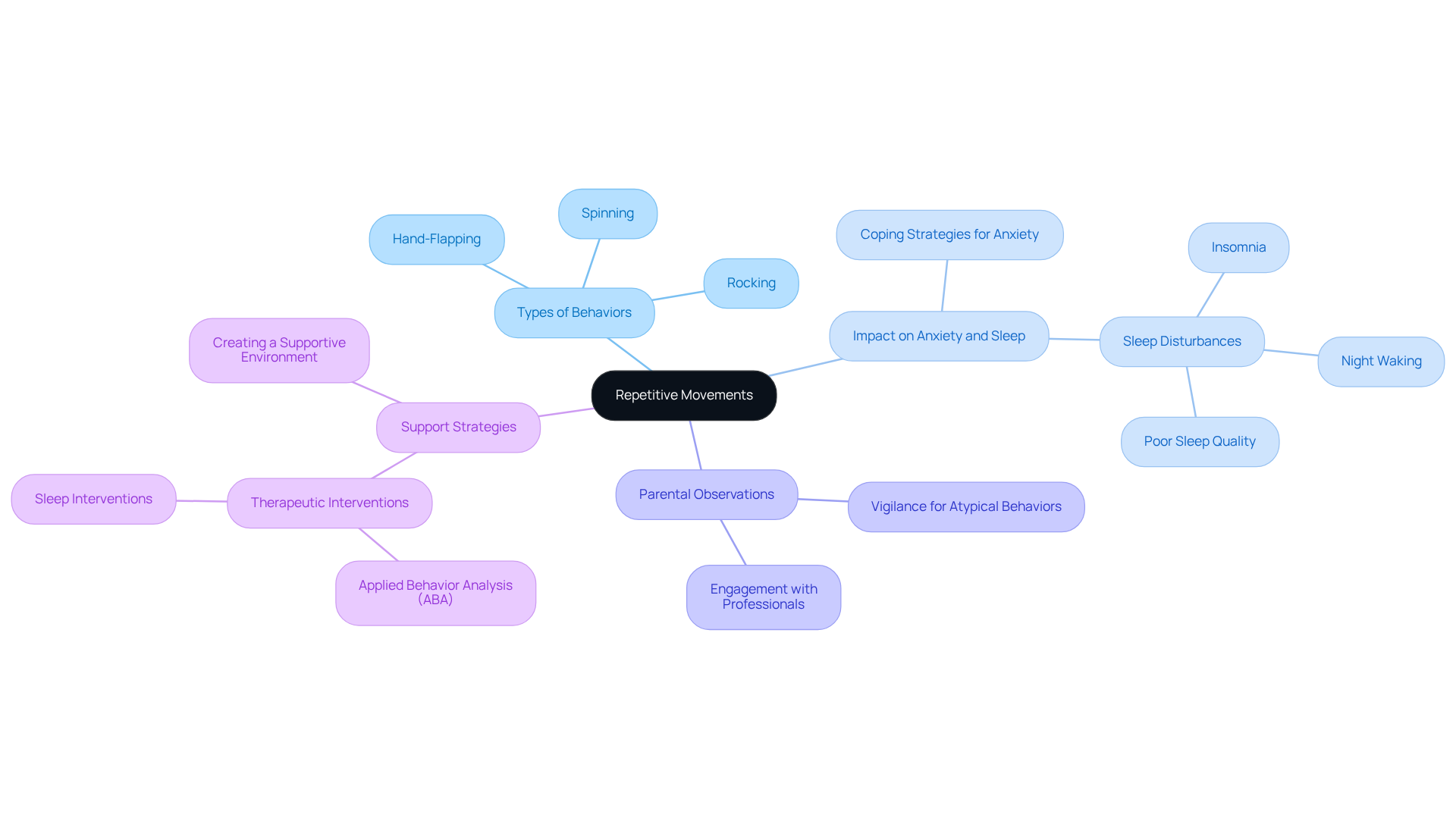
Sensory Sensitivities: Recognizing Overreactions to Sensory Input
Sensory sensitivities can be a significant challenge for many young individuals with autism, often manifesting as heightened reactions to sounds, lights, textures, or tastes. Imagine a child who becomes overwhelmed by loud noises or refuses to wear certain fabrics due to discomfort. For parents, recognizing these overreactions is vital, as they can greatly affect daily life and social interactions. Research shows that up to 90% of individuals with autism experience sensory hypersensitivity, highlighting the urgent need to address these sensitivities.
To support children in managing their sensory sensitivities, creating a sensory-friendly environment is essential. This might include strategies like:
- Sensory breaks, allowing young individuals to step away from overwhelming stimuli and engage in calming activities.
- Weighted blankets can provide deep pressure, offering comfort and security.
- Noise-canceling headphones can help reduce auditory overload.
- Cognitive behavioral therapy (CBT) can be beneficial in addressing interoceptive hypersensitivity, helping children learn to interpret their internal bodily sensations.
Experts stress the importance of customizing environments to meet each child's unique sensory needs. For instance, reducing exposure to bright lights and providing soft textures can create a more accommodating space. Incorporating visual schedules can also help children anticipate their day, easing anxiety related to unexpected changes. Grace Baranek, an expert in occupational therapy, emphasizes that understanding sensory processing is crucial for developing effective interventions. By recognizing how sensory processing difficulties can impact academic performance and addressing these challenges, parents can empower their children to navigate the world more comfortably.
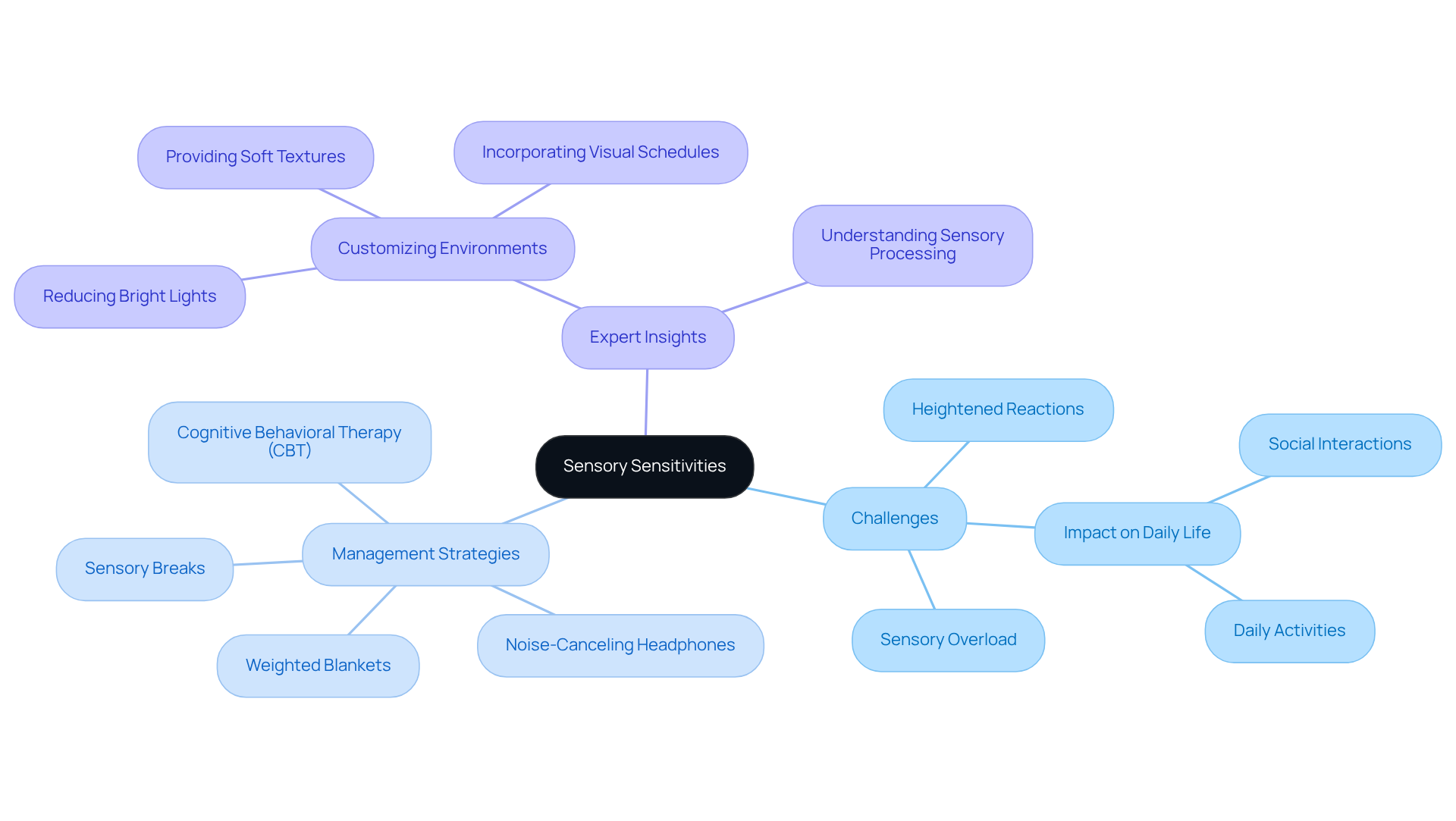
Poor Eye Contact: Identifying Non-Verbal Communication Issues
Many parents notice that their children on the autism spectrum often struggle with eye contact, which may be considered as early signs of autism. This can be particularly challenging during conversations or interactions, as early signs of autism, such as avoiding eye contact, may hinder their ability to form social connections. To support your child, consider engaging in face-to-face activities that encourage eye contact, such as:
- Reading books together
- Playing games that require looking at each other
It's important to remember that positive reinforcement can be a powerful tool. When your child makes eye contact, celebrate those moments! This not only boosts their confidence but also helps improve this essential communication skill. By fostering an environment of understanding and support, you can make a significant difference in your child's social interactions.
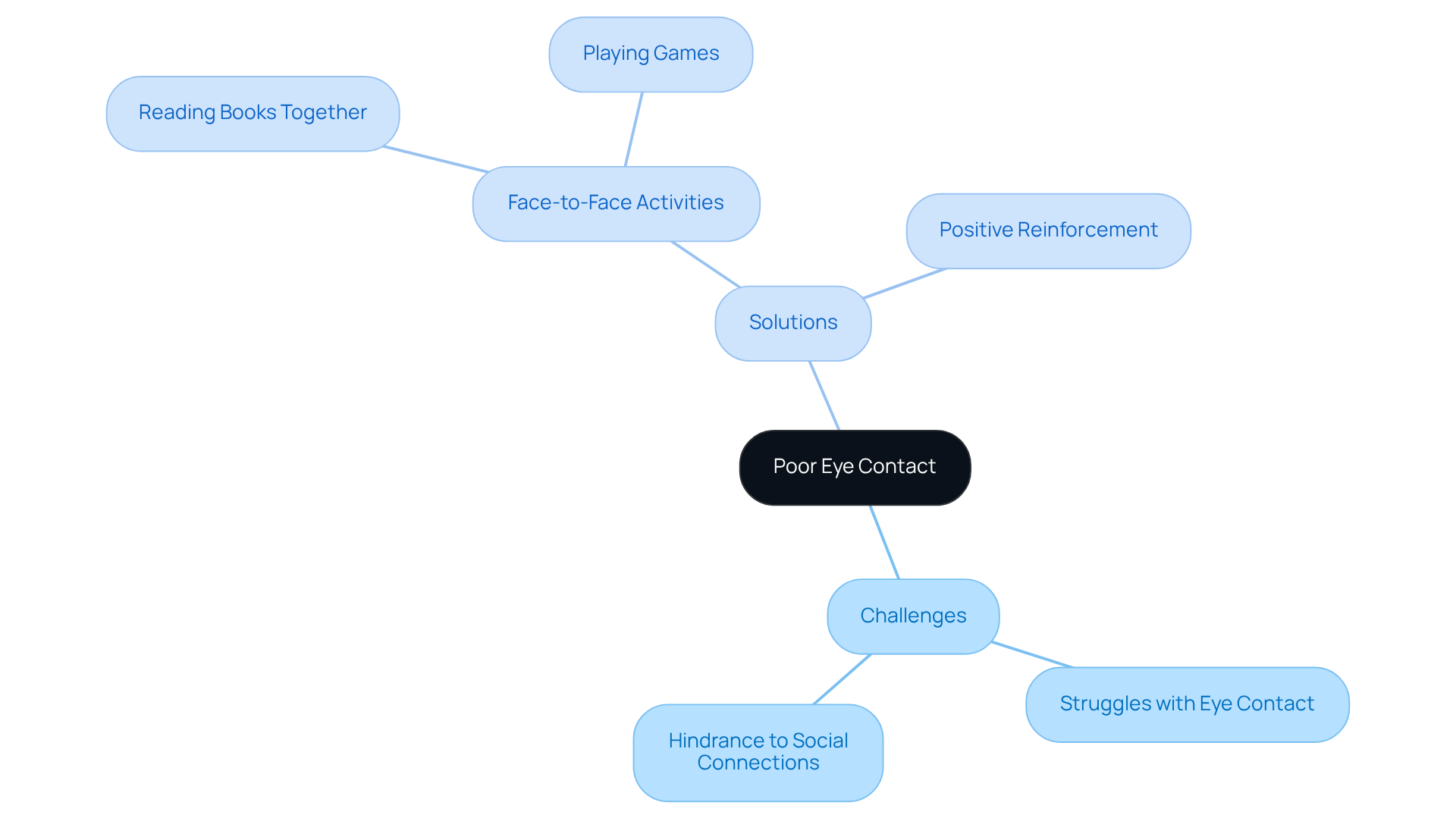
Atypical Play Patterns: Understanding Unusual Approaches to Play
Children with early signs of autism often exhibit unique play patterns, such as lining up toys instead of engaging in imaginative play. This can be concerning for parents, as studies indicate that individuals with early signs of autism demonstrate less functional play. They may engage with toys less frequently, with less variety, shorter duration, and less integration of play components compared to typically developing (TD) children. It's common for them to prefer repetitive actions with toys, rather than exploring various play scenarios.
To nurture creativity and social interaction, parents can introduce new toys and activities that encourage diverse play experiences. Observing how your child plays can provide valuable insights into early signs of autism and their developmental needs. It's important to remember that organized play therapy has shown promising results. Research suggests that 14 hours each week of parental floor time play therapy led to advancements in development and reduced indicators of developmental disorders in 47% of young children.
By promoting imaginative play, you can significantly enhance your child's social communication abilities, ultimately aiding their overall development. This journey may have its challenges, but with understanding and support, you can make a meaningful difference in your child's life. What experiences have you had with your child's play? Sharing these can help foster a community of support and understanding.
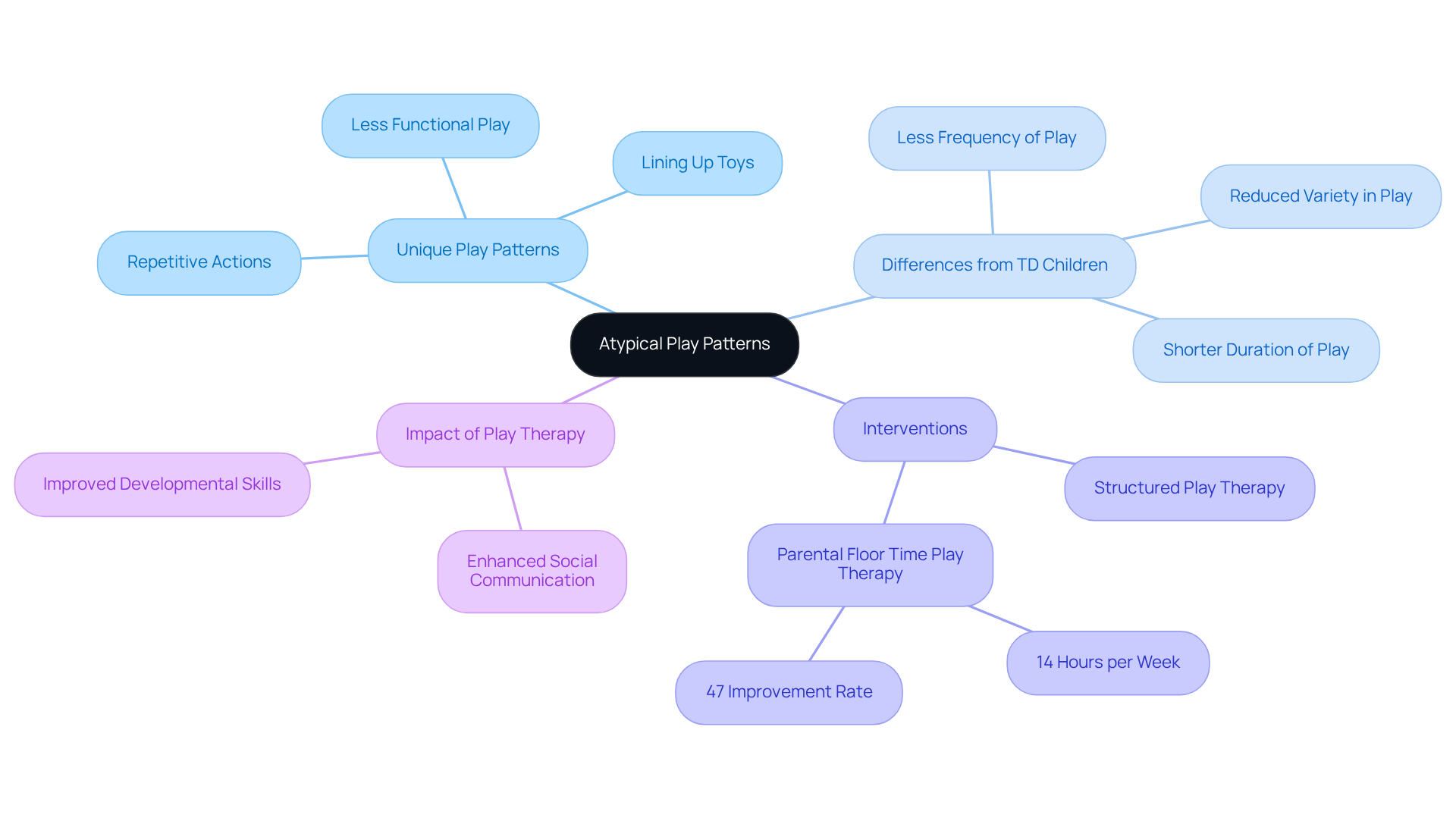
Limited Emotional Expression: Recognizing Atypical Responses to Emotions
Children on the spectrum often exhibit restricted emotional expression, which can make them seem indifferent or unresponsive to the emotional cues from those around them. This can be particularly challenging, as they may struggle to convey their own feelings or fully grasp the emotions of others. Research shows that individuals with autism experience significant difficulties in overall emotion recognition accuracy, with a standardized mean difference of -1.29 (p < 0.01). This statistic highlights the hurdles they face in expressing emotions.
To foster emotional development, parents can play an active role by labeling emotions during interactions, helping their children recognize and articulate their feelings. Engaging in organized activities that promote emotional awareness—such as role-playing or using emotion cards—can greatly enhance young people's understanding of their own emotions as well as those of others. As Annie S. Mills points out, "youth with developmental disorders have been found to experience greater difficulties with emotion regulation than peers without such conditions." This underscores the importance of implementing supportive strategies.
It’s also essential to acknowledge the nuanced and complex nature of emotional responses in toddlers with ASD. These complexities necessitate a multimethod approach to effectively nurture their emotional competencies. Moreover, the subdued emotional reactions often observed in these children may pose potential safety risks, as emphasized by Dr. Chawarska. Therefore, it is crucial for caregivers to actively encourage emotional awareness in their children. By doing so, they can help pave the way for a more emotionally connected and safe environment.
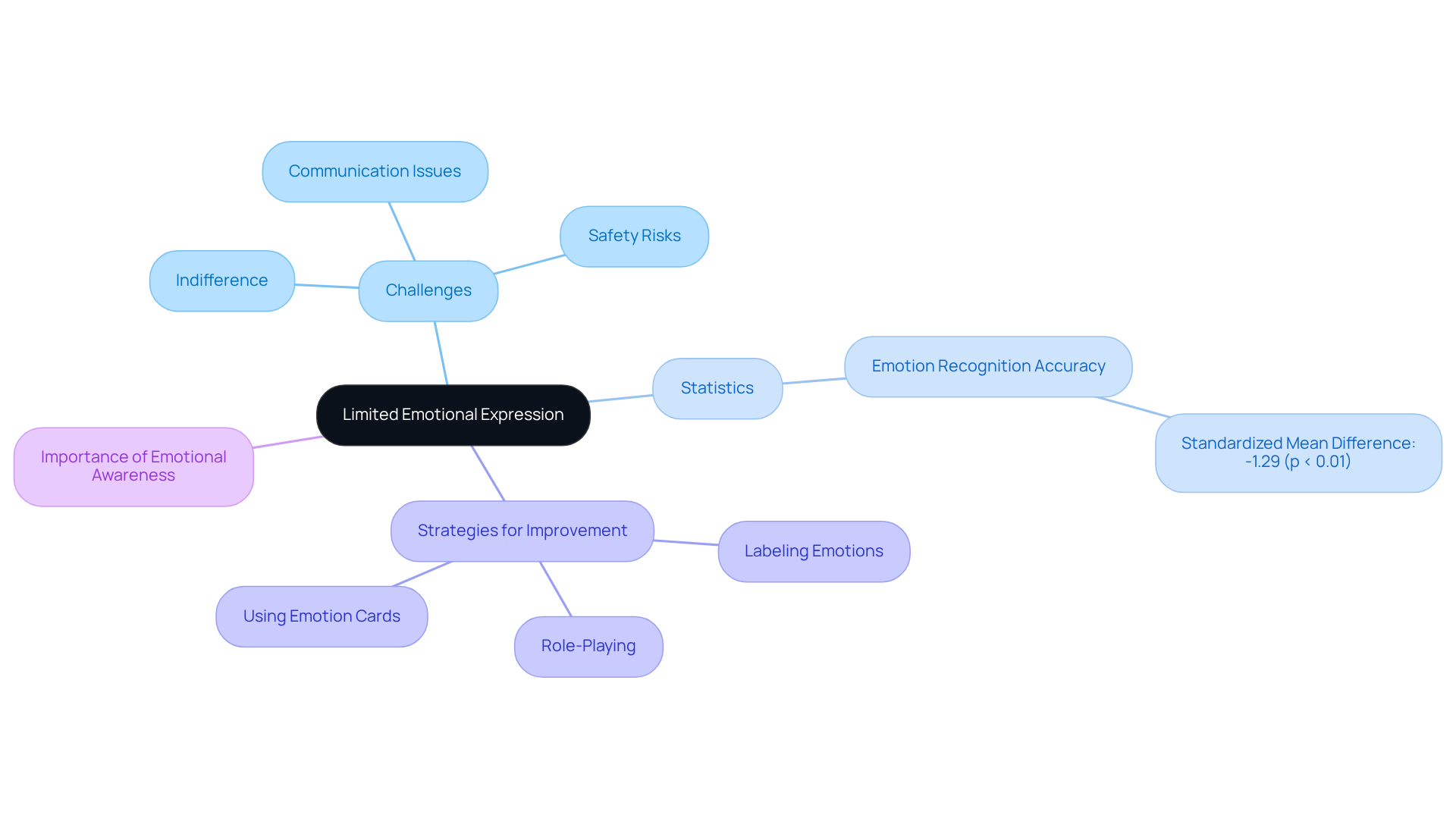
Seeking Professional Evaluation: Taking Action on Early Signs of Autism
When parents notice early signs of autism in their children, it becomes essential to seek a professional assessment. Early diagnosis can lead to timely interventions that greatly improve developmental outcomes. For instance, research shows that among individuals aged 8 years with ASD, 39.6% were assessed by 36 months. However, most are diagnosed after the age of 4, even though early signs of autism can be accurately identified as early as 2 years. Pediatricians stress that addressing concerns promptly can open the door to vital resources and support.
As the CDC highlights, "Autism impacts an estimated 1 in 36 youths in the United States." It's crucial for parents to consult with specialists in child development to discuss their observations and explore assessment options. Engaging with organizations like ASD Media can offer invaluable guidance and resources throughout this evaluation journey. These resources include:
- Strategies for managing challenging behaviors
- Navigating support services
This ensures that families feel well-supported as they navigate this important process.
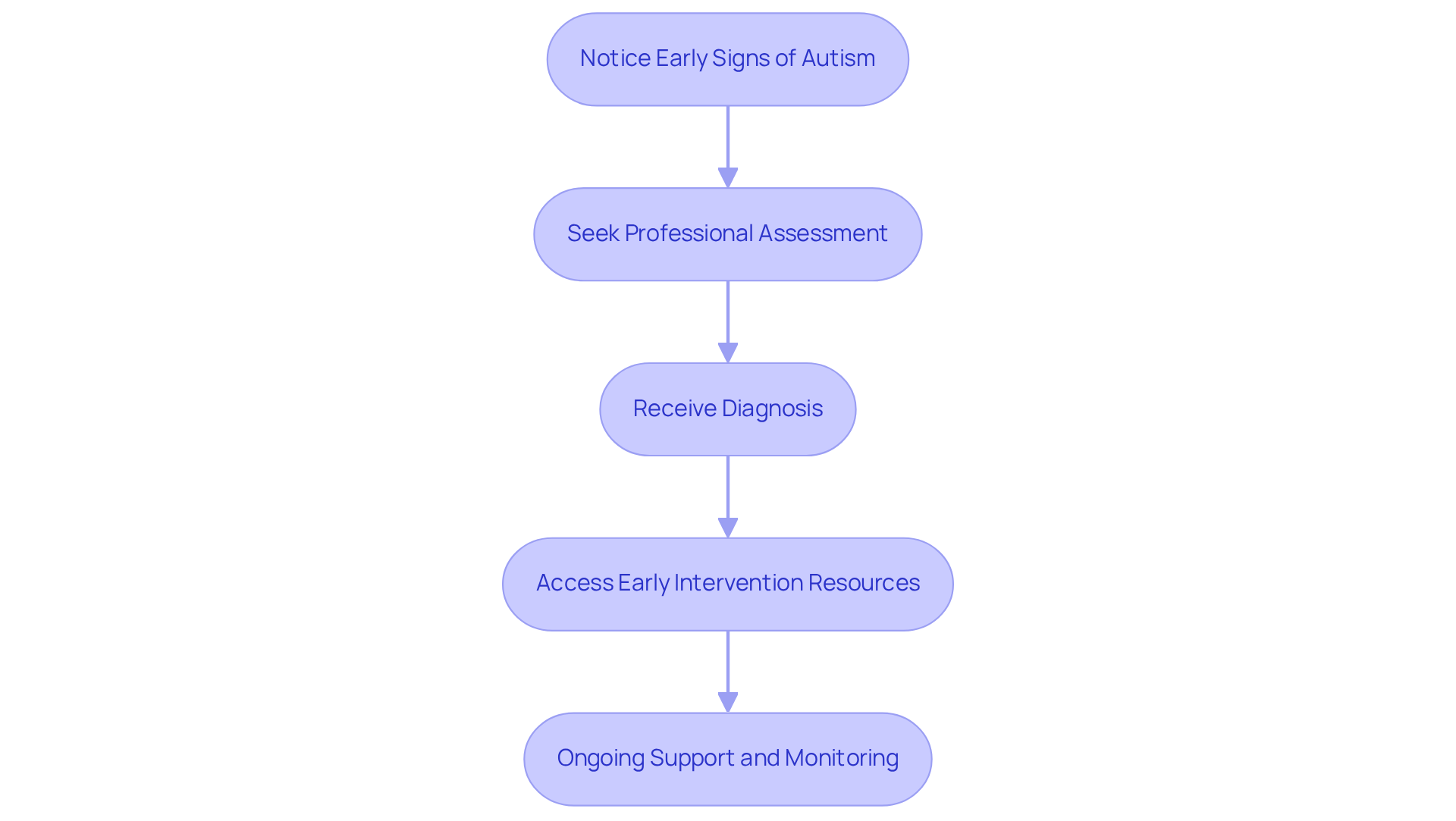
Conclusion
Recognizing the early signs of autism is crucial for parents who wish to support their child's development effectively. By understanding these indicators—such as lack of joint attention, delayed speech, limited social interaction, and sensory sensitivities—caregivers can take proactive steps to facilitate timely interventions. This awareness not only helps in identifying potential challenges but also empowers parents to create nurturing environments that foster their child's growth.
The article highlights the importance of early detection and intervention, emphasizing that children diagnosed with autism at a younger age often experience better outcomes. Engaging in community support programs, seeking professional evaluations, and utilizing available resources are vital steps for parents navigating this journey. By fostering communication, encouraging social interactions, and recognizing atypical behaviors, caregivers can significantly impact their child's developmental trajectory.
Ultimately, early recognition of autism signs is not just about diagnosis; it is about creating a supportive network that promotes understanding and growth. Parents are encouraged to remain vigilant and proactive, seeking the necessary resources and support systems to ensure their child thrives. By taking these steps, families can foster a brighter future for their children, helping them navigate the world with confidence and resilience.
Frequently Asked Questions
What is the mission of ASD Media?
ASD Media is committed to enhancing the execution of ABA therapy and empowering families through education and community support, ensuring parents have access to resources for the early identification of developmental disorders, particularly autism.
How prevalent is autism in the U.S.?
Autism affects 1 in 36 youths in the U.S., highlighting the urgent need for resources focused on early detection.
Why is community support important for early autism diagnosis?
Community support programs facilitate early diagnosis by promoting collaboration among families, healthcare providers, and educators, which can significantly improve identification rates of early signs of autism.
What are the benefits of early diagnosis of autism?
Individuals diagnosed with early signs of autism before age 3 benefit from more effective interventions, leading to better outcomes in adaptive behaviors.
What is joint attention, and why is it important?
Joint attention refers to the ability to share focus on an object or event with another person. It is crucial for language development and social skills, and a lack of it can indicate early signs of autism.
How can parents promote joint attention in their children?
Parents can encourage joint attention by creating engaging environments and using strategies that inspire their children to participate in shared experiences, such as pointing or showing interest in activities.
What are the signs of delayed speech development in children?
Signs of delayed speech development include not babbling by 12 months, not using single words by 16 months, and not combining two words into simple phrases by 24 months.
Why is it important to monitor speech development milestones?
Monitoring speech development milestones is essential because early intervention can significantly enhance communication outcomes and mitigate challenges in social interactions and academic performance.
What interventions can help with delayed speech development?
Effective interventions, such as speech-language therapy, have shown notable improvements in communication abilities, especially when initiated early.
How can parents support their child's language development?
Parents can support language development by engaging in regular conversations, reading age-appropriate books, and encouraging verbal expression through play and language games.




